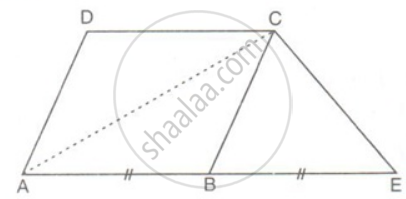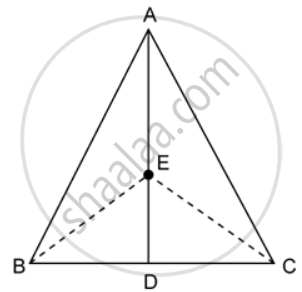Advertisements
Advertisements
Question
Find the area of a rhombus whose perimeter is 260cm and the length of one of its diagonal is 66cm.
Solution
The perimeter of the Rhombus = 260cm
Each side of the Rhombus = `(1)/(4)(260)` = 65cm
In the given, Rhombus, AB = 65cm, diagonal AC = 66cm
We know that, diagonals of a Rhombus bisect at right angles.
In Triangle AOB,
∠AOB = 90°, AB is the hypotensue
AO = `33"cm"(1/2 (66"cm"))`
AB2 = OB2 + OA2
⇒ OB
= `sqrt("AB"^2 - "OA"^2)`
= `sqrt(65^2 - 33^2)`
= `sqrt(4225 - 1089)`
= `sqrt(3136)`
= 56
⇒ AB = 112cm
We know that the area of a rhombus whose diagonals are d1 and d2, is
A = `(1)/(2) xx "d"_1 xx "d"_2`
∴ the area of a rhombus whose diagonals are 112 and 66, is
A = `(1)/(2) xx 112 xx 66`
= 3696cm2.
APPEARS IN
RELATED QUESTIONS
State, 'true' or 'false'
The diagonals of a rectangle bisect each other.
State, 'true' or 'false'
The diagonals of a quadrilateral bisect each other.
In the figure, given below, AM bisects angle A and DM bisects angle D of parallelogram ABCD. Prove that: ∠AMD = 90°.

The given figure shows a square ABCD and an equilateral triangle ABP. 
Calculate: (i) ∠AOB
(ii) ∠BPC
(iii) ∠PCD
(iv) Reflex ∠APC
In the given figure, if AB ∥ DC ∥ FG and AE is a straight line. Also, AD ∥ FC. Prove that: area of ∥ gm ABCD = area of ∥ gm BFGE.
In the figure, AE = BE. Prove that the area of triangle ACE is equal in area to the parallelogram ABCD.
In the given figure, ABC is a triangle and AD is the median.
If E is any point on the median AD. Show that: Area of ΔABE = Area of ΔACE.
Two adjacent sides of a parallelogram are 34 cm and 20 cm. If one of its diagonal is 42 cm, find: distance between its shorter sides
One side of a parallelogram is 12cm and the altitude corresponding to i is 8cm. If the length of the altitude corresponding to its adjacent side is 16cm, find the length of the adjacent side.
Two adjacent sides of a parallelogram are 20cm and 18cm. If the distance between the larger sides is 9cm, find the area of the parallelogram. Also, find the distance between the shorter sides.
The length of a rectangular field is thrice of its width. If the perimeter of this field is 1.6km, find its area in sq.m.
A rectangular floor 45 in long and 12 m broad is to be paved exactly with square tiles, of side 60 cm. Find the total number of tiles required to pave it.
If a carpet is laid on the floor such as a space of 50 cm exists between its edges and the edges of the floor, find what fraction of the floor is uncovered.
The perimeter of a square is 128cm and that of another is 96cm. Find the perimeter and the diagonal of a square whose area is equal to the sum of the areas of these two squares.
Find the area of a rhombus, whose one side and one diagonal measure 20cm and 24cm respectively.
In quadrilateral ABCD, ∠A + ∠D = 180º. What special name can be given to this quadrilateral?
All the sides of a rhombus are of equal length.
Give reason for the following :
Squares, rectangles, parallelograms are all quadrilaterals.
A figure is said to be regular if its sides are equal in length and angles are equal in measure. Can you identify the regular quadrilateral?
Name polygon.

Make two more examples of this.
